2014 President's Fall Address
Renu Khator
University of Houston
Fall Address
October 1, 2014
Thank all of you for being here this morning in this beautiful and inspiring Moores Opera House.
As I start my 7th Fall Semester with you, I am reminded of what a blessing it is to travel with you on our shared mission of transforming our great university into a greater one. And yes, the journey, although far from being complete, is already receiving national accolades. You are doing what few are able to do — transformation on a big scale — but then, as they say, anything is possible in Houston and, nothing is too big for Texas.
At the helm of our journey is the vision and commitment of our regents, many of whom are present today – along with former board chairs and regents. No words will be sufficient to thank you for your continued guidance and support.

Student Success
Four years ago, we, together, agreed to make student success our no-excuse priority because we understood that without a credible student product, we could not be credible as a research university. At the time, the task seemed insurmountable and I recall a meeting where a staff member expressed his doubt by saying, “What I do is so small. How could I ever make any difference?” And I remember saying that our individual efforts are like small streams of water flowing from the mountain top. After time, these streams merge and form a river, which eventually joins the ocean and before you know it, the force of the change, as large as the ocean, is before us.
Today is the time to encounter that ocean. Today is the time to see how our individual streams are turning into a forceful river with the ocean now in sight. Let’s begin with the topic that is close to my heart, undergraduate education.
Access, affordability, relevance, and success are the four pillars of a powerful undergraduate experience.

Our enrollment, after taking a dip last year as a result of recent changes, including new admissions standards, is back on its upward trajectory. It is up by nearly 4%, but more important, semester credit hours are up by nearly 5%, indicating that more and more students are registering full time. They understand the value of completing on time and getting into the workforce early.

The same story holds true for freshmen.
The 2018 class is larger, stronger, and more diverse than ever before.
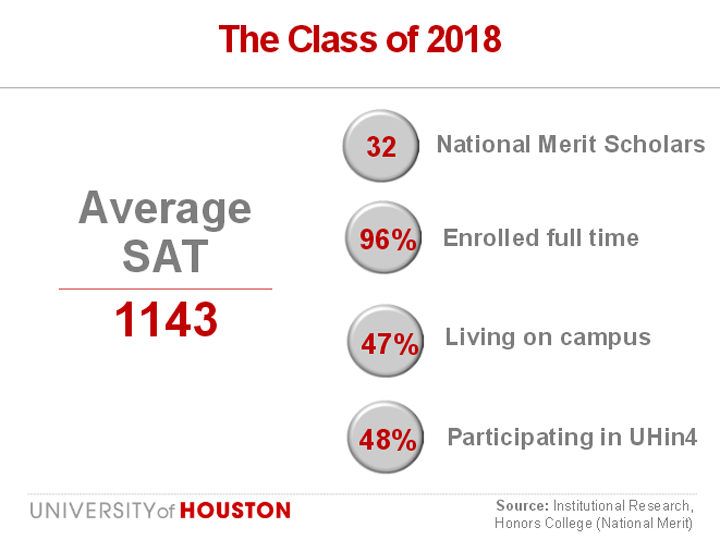
- The average SAT is 1143.
- There are 32 National Merit Scholars, compared to three just six years ago.
- 96% of our freshmen are enrolled full time, with 69% enrolling in 15 credit hours or more.
- 47% of them have chosen to live on campus.
More importantly, nearly half of them have chosen to participate in UHin4, a program offering 4-year fixed tuition and a graduation plan. The UHin4 program has been a phenomenal success — I set a goal of enrolling 30% of our freshmen, and our wonderful staff from all across the university beat my goal by enrolling nearly half of them, proving to me that I am not dreaming big enough. I would like to congratulate everyone who was involved with UHin4.
But, wait. We take at least as many transfer students as we do freshmen, so let’s take a look at our transfer class.

It, too, is bigger and stronger than ever before. More of our transfer students have completed their AA degrees and more than ever have a GPA of 3.0 or better.

We have provided access while making the University even more affordable.

Last year, we were already ranked by Princeton Review and U.S. News & World Report as being one of the most affordable universities in the nation. We were also ranked by PayScale and PolicyMic for offering one of the best returns on investment to students.

This year, we have added to the list a new recognition — a recognition by the White House in its first-ever rating system — as being a university that is low in cost, low in borrowing and low in student default rate.

Along with access and affordability, we are also relevant to our city and fuel the economy of our state.

Enrollment in the Petroleum Engineering program now stands at 929 and Subsea Engineering at 281.

Similarly, our newly launched health programs in Biomedical Engineering and Honors Biomedical Science degree have grown significantly.

Overall, we are graduating more and more students in STEM fields, a critical state and national priority. Being the only non-STEM major in my family, I often say that everyone, even engineers and scientists, needs their souls nourished and their thinking broadened. We are indebted to the liberal arts and the humanities for feeding our hearts and souls. I am pleased to say that we are equally successful in expanding our programs in non-STEM fields, including a steady pipeline into Houston’s thriving arts economy, the fourth largest in the nation.
Reflecting the DNA of our city, we are training our students to be entrepreneurs, like these teams from the Wolff Center for Entrepreneurship. Using technology developed by UH faculty members, Dr. Debora Rodrigues and Dr. Allan Jacobson, both student teams, WAVVE and REEcycle, developed business plans and took home first place, one in a national competition and one in a global competition. The WAVVE and REEcycle teams certainly deserve a big round of applause.


But ultimately, the proof of the pudding is in its taste. Success is not about what we try to do, but what gets done. Are students succeeding and graduating? As I visited 17 freshman classes during the first week of the semester, I asked each class if anyone had come to the university with a plan to have fun and drop out. Not a single hand was ever raised. Then I asked them to look at the person sitting to their right and I said, “Now, face the reality that unless we —you and the university — change things, only one person, either you or the person sitting next to you, will graduate in six years. Every time I said this, eyes got wide open, jaws dropped, and a soft sound of sudden shock filled the room.
We knew that we have to change things, and therefore we have undertaken many initiatives. Here are the results to ponder.

One-year retention — from freshman to sophomore — is now at a point where we are nationally competitive. We have surpassed the average of national universities as recognized by U.S. News & World Report and are closer to catching up with the average of Tier One public universities.

We, of course, still lag behind in our graduation rate, but it is a matter of time. Even if nothing else were to change, the UHin4 program — the fixed 4-year tuition and completion plan — alone will move the graduation rate above the national average. This is the power of one program. Imagine the combined effect of everything that we have initiated on campus!

Looking at the other end of the pipeline, we are awarding more degrees than ever
before.

And we are awarding them to students from historically underserved populations. Even during the time when the high school pipeline for African American college students declined, we helped more of them to succeed and earn their University of Houston degrees.
There is no doubt in my mind that a powerful experience leads to more pride and confidence in students. Other than graduating on time, they scream louder.

Yes, there were 4,000 students at the Cage Rage pep rally, and 10,000 students at the first football game! Congratulations to the SGA and the amazing team for rallying the students.
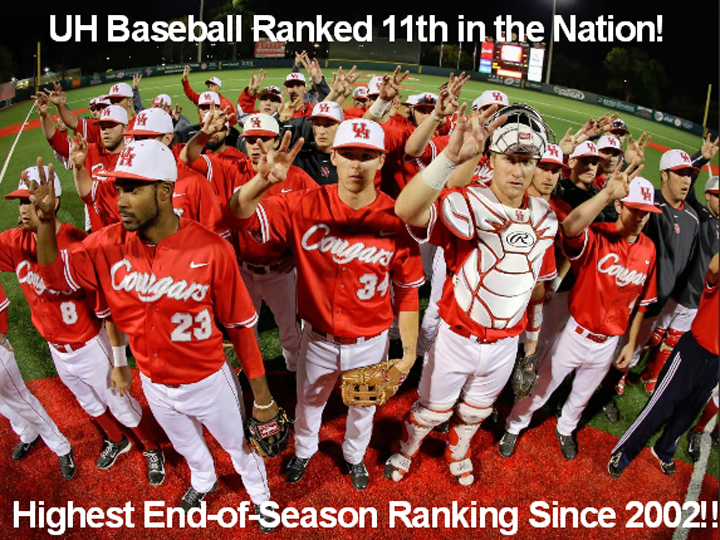
Pride and confidence help our students win championships. What a spectacular performance by the Cougar baseball team, who won the AAC championship!

Pride and confidence help students become best in the world, like these teams from the Bauer College of Business who won 2nd and 3rd places in the International Google Competition in marketing, beating teams from all over the world.
Research and Scholarship

Moving on to research, let’s acknowledge that research is the differentiator for the University of Houston, and it is what has earned the University of Houston a place on the list of national Tier One universities. Like student success, research can be measured in four critical areas, all related to knowledge: receiving funds to create new knowledge; sharing knowledge through publications; applying knowledge for the betterment of the society; and finally, helping to prepare new knowledge creators for the future.
Our research expenditures, a Tier One measure, continue to be on the rise, but we needed to break away from the incremental increases, and we already see a changed pattern.

Just as the first-year retention rate is the indicator of what is to come in four years, the submission of proposals is an indicator of what is to come in future years. Thanks to the strategic hiring of faculty and emphasis on cross-disciplinary projects, we see a dramatic shift in our submission rate.

Another Tier One measure is the number of members of National Academies among a university’s faculty. With this year’s addition of two new members, we now have 14 superstars among us, each worthy of our highest recognition.

Funding allows researchers to pursue their research interests, but it is the sharing of their research findings that truly expands the frontiers of knowledge. On the national list of faculty whose work is most used by fellow faculty and researchers are two of our own.

Researchers Oomman Varghese and Maggie Paulose are not only listed on Thomson Reuters 2014 list of highly cited researchers in materials science, but are also included on the list of the “World’s Most Influential Scientific Minds.” To warm your hearts, let me also tell you that the two are husband and wife.

Our faculty members are successfully contributing articles to the nation’s top journals. It is a sign of growing research impact as well as dominance by our faculty.

For the faculty in the arts and humanities, writing books is the primary way of sharing their newly discovered knowledge and we have many who have done so. I would like to acknowledge everyone in attendance whose papers have been published in the top journals or are the authors of books published in last two years. I salute you all.

Research is not all about sharing and publishing, it is also about applying it to the common good of the society.

Well, we top the chart in this category, with $22 million of royalty income per year!

As of last week, we are ranked:
#1 in the nation among all public universities that do not have a medical school.
With students winning national competitions and faculty winning a market share of their products, I think we have earned the right to call ourselves the innovation university.

It is not possible to move away from this topic without mentioning another significant recognition. Early in the year, Professor Betsy Cook Weber was selected by the Houston Symphony to serve as Director of the Houston Symphony Chorus. What an honor for Betsy and what a tremendous recognition for the University of Houston!

An important obligation of research is to ensure that future researchers are prepared, and we fulfill this obligation through our doctoral programs.


Recently, the National Science Foundation provided UH with a $3.3 million grant to launch a program to prepare more women, particularly minority women, as faculty and researchers. The program, called ADVANCE, has been awarded to a select group of research universities in the nation, and we are indeed pleased to have one.
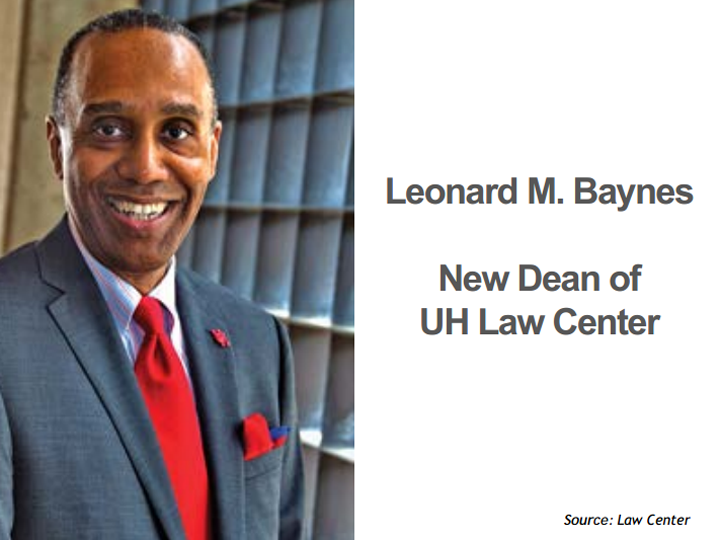
Speaking of academic leadership, let me welcome our new dean of the UH Law Center,
Leonard Baynes, an incredible addition to the Cougar Powerhouse.
Support

Now let’s turn to our support structure. I have always said that great universities are built by great communities. This year, I want to start with faculty and staff giving.

You give generously of your time and talent each and every day, but you have also shown your support through annual giving, which is up 42% since 2008.

Private and foundation gifts broke another record this year…that is three years in a row!

We have also experienced remarkable growth in planned giving, from $3 million to $27 million! What can be a better vote of confidence in the direction of the university than this trend! We thank our alumni and other donors — with every gift, you are making the University of Houston a better place in which to live and learn.
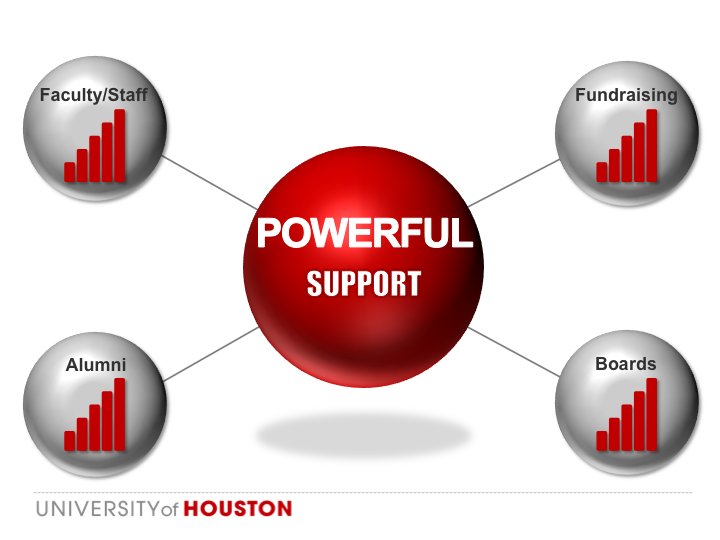
It has been a year since the UH Alumni Association merged with the university to enhance alumni-student engagement. Among many new programs launched one already stands out, and it is called Cougar Send-Off.
Under this program, our alumni host a reception in their own cities to welcome and connect with new students as they leave home to come to UH.
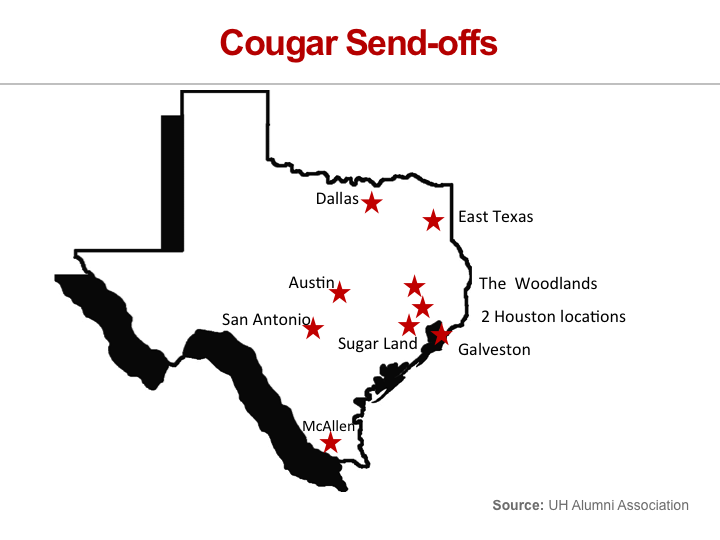
Eleven Cougar Send-Offs were hosted throughout the state and they were greatly successful.
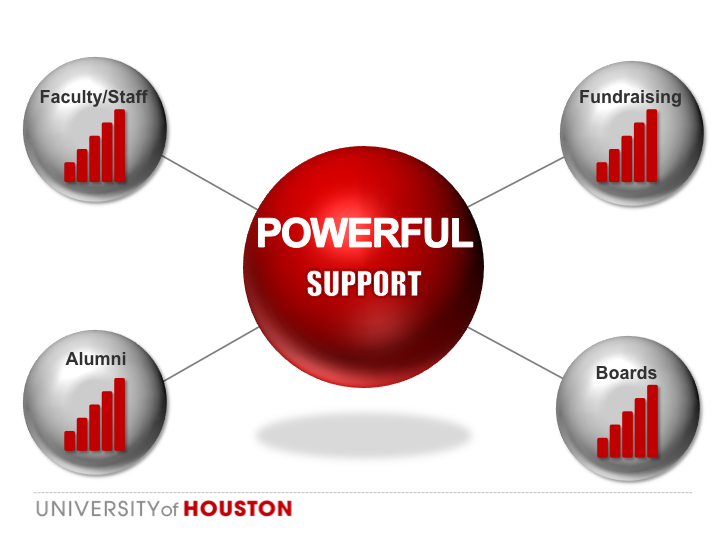
We at the University of Houston recognize that we are not alone in our pursuit of excellence.
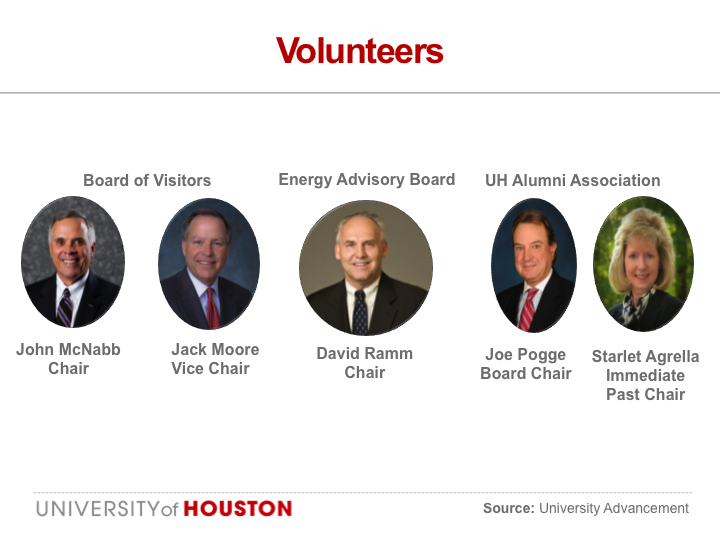
Three external boards with nearly 100 successful and passionate leaders are on this journey with us. The UH Board of Visitors is our newest board, chaired and co-chaired by John McNabb and Jack Moore. John is not an alumnus, but believes that the success of UH is critical to the success of the city of Houston. We want to welcome officers in attendance from the UH Alumni Association Board of Directors, the UH Board of Visitors and the UH Energy Advisory Board. We are so glad you are here today.
Facilities
If you want to see the most visible sign of change, walk on campus with a visitor. I have yet to walk with anyone new to our university whose first words are not “wow, wow and… wow!”
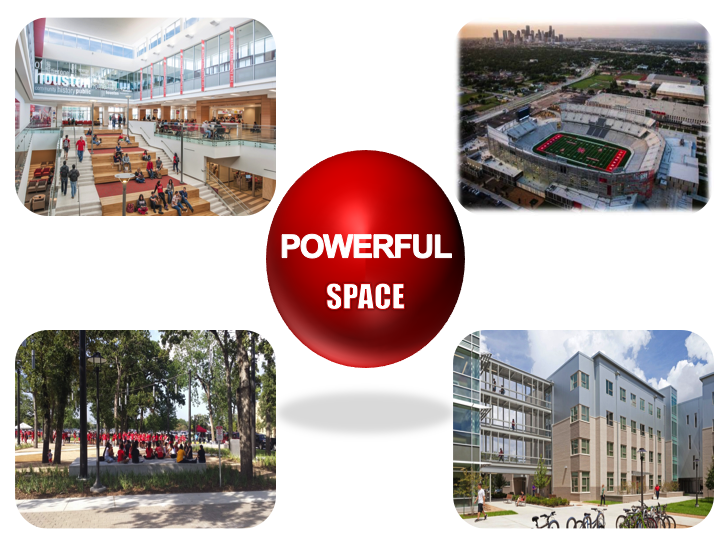
Here is a look at the last four new spaces that we have opened — Phase One of the UC transformation, the TDECU Stadium, the Grove and Cougar Place.

And here is a look at what is on the horizon. These projects include the Multi-Disciplinary Research and Engineering Building, the Houston Basketball Development Facility, the completion of Phase Two of the University Center, the Health and Biomedical Sciences 2, which will house the College of Pharmacy and health clinics, among many exciting things.
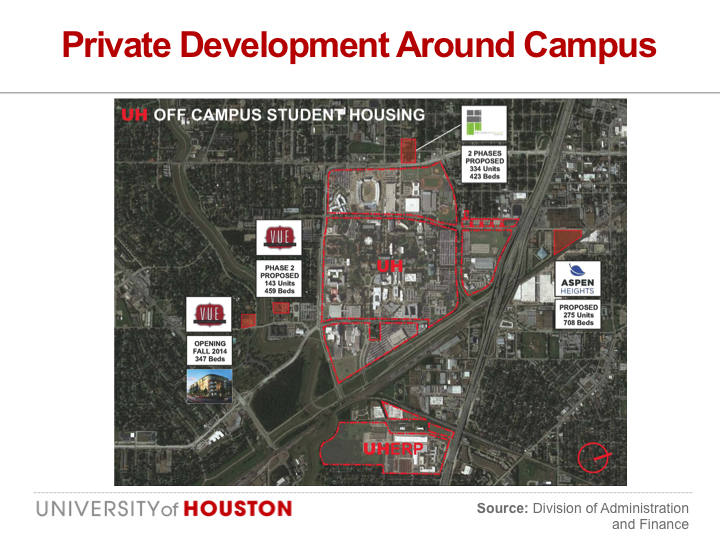
But the most powerful statement is not what we think of ourselves, but what the independent private sector is thinking of us. Four residential communities with nearly 2,000 additional beds are underway on the periphery of the campus. This kind of development is sure to impact the neighborhood and under the leadership of the Rev. Bill Lawson and VP Elwyn Lee, we have begun to work with neighborhood leaders to see how the University could be more helpful in shaping our common future.
What’s Next?
Now that our smaller streams of water have become a river, and now that we have the force of the ocean in sight, what do we do next?
First of all, we have to stay focused on our goal of student success. Our goal is to help every single student earn his or her degree from the University of Houston. Getting students to participate in UHin4 is commendable, but it is only the first step. Now we have to help them stay focused and give them the support they need to complete their degrees. Therefore, student success will continue to be our no-excuse priority.
Our next defining moment in research will come not from incremental growth, but from
getting a large, federally-funded, national research center. We have at least two
areas of superior strength and readiness to compete for such a center: superconductivity
and subsea engineering. In the coming years, we will aggressively compete in these
areas while continuing to invest in stellar programs of national prominence across
various disciplines.
UH Health, one of our big rocks, launched last year, is still in its infancy and
will need nurturing. In the coming years, we intend to implement the recommendations
of the Health Workgroup, including a primary care clinic, expansion of pharmacy, doctor
of nursing, doctor of physical therapy, a Ph.D. in Health Sciences, and down the road,
a primary care, community-based medical school. The recommendation of the Health Workgroup
is to not duplicate anything currently available in Houston, but to build upon it
and focus entirely on community-based research and training.
It is also time for us to move forward with our third rock, UH Arts. This year, we will implement the recommendations of the Arts Workgroup and will establish a College of the Arts.
Our efforts to build a nationally competitive athletics program will continue. I could list the nationally competitive performances by many of our teams, including golf and tennis, but let me highlight the point that I am most proud of, i.e., the academic performance of our student-athletes, which is better this year than it has ever been in the history of the university.
As per our board directive, we will complete the transition plan in Sugar Land. The University of Houston, along with its sister universities, has an obligation to serve the region, and we will do our best to fulfill this obligation.
Finally, when was the last time you heard that the University of Houston is better known outside the city than inside? Shall we say, No More! Beginning in November, you will notice our “Powerhouse” campaign everywhere, but most importantly, you will see it at both Houston airports, and here is what you will see.

To conclude, let’s remind ourselves again that Tier One is a journey. The road ahead is full of challenges that are serious because the landscape of higher education itself is changing more rapidly than ever. We have to remain relevant and provide value for our work, whether it is in the area of teaching or research or service.
Think for a second about the challenges that America is facing and the critical role that our university is bound to play.
- Only 39% of Americans today have some form of post-secondary education – yet 63% of the jobs in 2018 will require such credentials!
- Only 16% of the students today fit the traditional mold of college students; and yet 84% others have to be served!
- With the changing demographics, America’s future will depend on the strength of its underserved populations —minorities and low income, and yet college remains elusive to these very groups. Did you know that…
…if you are born in the highest quartile of family income, you have 85% odds of earning
a college degree, but if you are born in the lowest quartile of family income, your
chances are only 8%?
…if none of your parents have a post-secondary education, your chances of ever even
enrolling in college, let alone completing, are less than 30%?
…if you are Hispanic, your chances of earning a college degree are 50% less than
the population at large?
As disturbing as these trends are, they make us relevant to the nation. Our diversity makes us a prototype… the University of Houston is today what other universities will be in 20-25 years.
But we, the University of Houston, are not just diverse — we are also a Tier One university, nationally ranked in teaching, research and innovation.
We are founded on the promise of making education accessible to the average working class man and woman. With our efforts, we are proving each and every day that diversity and excellence are not mutually exclusive. They can be and must be one and the same. Our dreams and aspirations are testimony that …
…an average man deserves more than the average. He deserves the best!
…an ordinary woman deserves more than the ordinary. She deserves the extraordinary.
Our vision is not to exclude the average man, but to dream more than the average for him… to dream the best for him. Let us never forget that we are the University of Houston, a university whose success is critical to the city, but it is equally important to the nation. We have a responsibility to turn our diversity into strength and build a world-class university right here in Houston. It is our challenge, but it is also the source of our energy!
In this challenge, I am glad that I am part of your team.
Every day, I am inspired by you.
Every day, I am encouraged by you.
And every day, I feel blessed to be with you.
Thank you and God bless you!